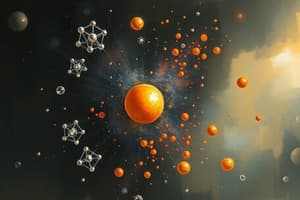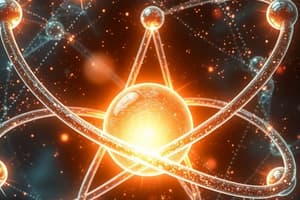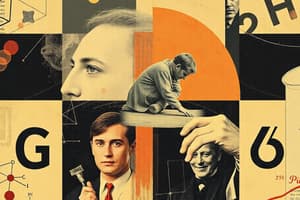Podcast
Questions and Answers
An atom has a mass number of 40 and contains 20 protons. How many neutrons does it have?
An atom has a mass number of 40 and contains 20 protons. How many neutrons does it have?
- 60
- 10
- 40
- 20 (correct)
Which statement accurately describes the relationship between isotopes of an element?
Which statement accurately describes the relationship between isotopes of an element?
- They have the same mass number but a different number of protons.
- They have the same number of neutrons but a different number of protons.
- They have the same number of protons but a different number of neutrons. (correct)
- They have the same number of electrons but a different number of protons.
An ion with a +2 charge has 10 protons. How many electrons does it have?
An ion with a +2 charge has 10 protons. How many electrons does it have?
- 2
- 10
- 8 (correct)
- 12
What distinguishes one element from another?
What distinguishes one element from another?
Which of the following describes a neutral atom?
Which of the following describes a neutral atom?
The atomic mass of copper on the periodic table is 63.55 amu. Why is this value not a whole number?
The atomic mass of copper on the periodic table is 63.55 amu. Why is this value not a whole number?
An atom gains two electrons. What is the resulting electrical charge of the ion?
An atom gains two electrons. What is the resulting electrical charge of the ion?
What information is provided by the mass number of an atom?
What information is provided by the mass number of an atom?
If two atoms have different numbers of neutrons, they are:
If two atoms have different numbers of neutrons, they are:
An element has two isotopes: Isotope 1 has a mass of 120 amu and a relative abundance of 40%, and Isotope 2 has a mass of 122 amu and a relative abundance of 60%. What is the average atomic mass of this element?
An element has two isotopes: Isotope 1 has a mass of 120 amu and a relative abundance of 40%, and Isotope 2 has a mass of 122 amu and a relative abundance of 60%. What is the average atomic mass of this element?
Which of the following changes will result in a different element?
Which of the following changes will result in a different element?
Which statement correctly describes the arrangement of elements in the periodic table?
Which statement correctly describes the arrangement of elements in the periodic table?
What does the nuclide symbol represent?
What does the nuclide symbol represent?
An atom has 16 protons and 18 electrons. What is its electrical charge?
An atom has 16 protons and 18 electrons. What is its electrical charge?
Consider chlorine, which has two common isotopes: chlorine-35 and chlorine-37. If the atomic mass of chlorine is approximately 35.5 amu, which isotope is more abundant?
Consider chlorine, which has two common isotopes: chlorine-35 and chlorine-37. If the atomic mass of chlorine is approximately 35.5 amu, which isotope is more abundant?
How is the number of neutrons in an atom determined using the mass number and atomic number?
How is the number of neutrons in an atom determined using the mass number and atomic number?
Which of the following particles is not considered when determining the mass number of an atom?
Which of the following particles is not considered when determining the mass number of an atom?
An atom of potassium has a mass number of 39 and contains 19 protons. How many neutrons are present in the nucleus?
An atom of potassium has a mass number of 39 and contains 19 protons. How many neutrons are present in the nucleus?
What is the correct nuclide symbol representation for an atom of carbon-14?
What is the correct nuclide symbol representation for an atom of carbon-14?
An element has three isotopes with the following masses and abundances: Isotope 1 (20.0 amu, 50%), Isotope 2 (22.0 amu, 30%), and Isotope 3 (24.0 amu, 20%). Calculate the average atomic mass of this element.
An element has three isotopes with the following masses and abundances: Isotope 1 (20.0 amu, 50%), Isotope 2 (22.0 amu, 30%), and Isotope 3 (24.0 amu, 20%). Calculate the average atomic mass of this element.
Flashcards
Nucleus
Nucleus
Central part of an atom containing protons and neutrons.
Proton
Proton
Positively charged particle found in the nucleus of an atom.
Neutron
Neutron
Neutral particle found in the nucleus of an atom.
Electron
Electron
Signup and view all the flashcards
Atomic Number
Atomic Number
Signup and view all the flashcards
Mass Number
Mass Number
Signup and view all the flashcards
Nuclide Symbol
Nuclide Symbol
Signup and view all the flashcards
Isotopes
Isotopes
Signup and view all the flashcards
Ions
Ions
Signup and view all the flashcards
Neutral Atom
Neutral Atom
Signup and view all the flashcards
Average Atomic Mass
Average Atomic Mass
Signup and view all the flashcards
Different elements
Different elements
Signup and view all the flashcards
Different isotopes
Different isotopes
Signup and view all the flashcards
Different ions
Different ions
Signup and view all the flashcards
Study Notes
Atomic Structure
- Atoms consist of a nucleus containing protons and neutrons, surrounded by electrons.
- Protons are positively charged, neutrons have no charge, and electrons are negatively charged.
Elements and Atomic Number
- The number of protons determines the element.
- One proton: hydrogen.
- Two protons: helium.
- Three protons: lithium.
- Atomic number: the number of protons in the nucleus.
Mass Number
- Mass number: the total number of protons and neutrons in the nucleus.
- Electrons are not considered when determining mass number due to their much smaller mass compared to protons and neutrons.
Nuclide Symbol
- Nuclide symbol: represents an atom using one or two letters to abbreviate the element name.
- One letter: capitalized (e.g., H for hydrogen).
- Two letters: the first is capitalized, the second is not (e.g., He for helium).
- Atomic number (number of protons) is sometimes written at the bottom left of the nuclide symbol (redundant but sometimes included).
- Mass number is written at the upper left of the nuclide symbol.
isotopes
- Isotopes: atoms of the same element with different numbers of neutrons, leading to different masses.
- Number of neutrons = mass number - atomic number.
Ions and Electrical Charge
- Ions: atoms with an electrical charge due to a difference in the number of protons and electrons.
- Neutral atom: the number of protons equals the number of electrons.
- Gaining an electron: results in a -1 charge.
- Losing an electron: results in a +1 charge.
Summary of Particle Variations
- Different numbers of protons: different elements.
- Different numbers of neutrons: different isotopes of the same element.
- Different numbers of electrons: different ions of the same element.
Periodic Table Arrangement
- Elements are arranged by atomic number on the periodic table.
- Atomic masses on the periodic table are not whole numbers because they represent average atomic masses for all isotopes of that element, reflecting the relative abundance of each isotope.
Calculating Average Atomic Mass
- Average atomic mass is calculated by multiplying each isotope's mass number by its abundance (as a fraction of one) and then summing the results.
- Individual atoms have a whole number mass number, but the periodic table displays average atomic masses.
Chlorine Example
- Chlorine can exist as chlorine-35 (17 protons, 18 neutrons) or chlorine-37 (17 protons, 20 neutrons).
- About 75% of chlorine atoms are chlorine-35, and 25% are chlorine-37.
Studying That Suits You
Use AI to generate personalized quizzes and flashcards to suit your learning preferences.




